This tutorial demonstrates how to use the marching cubes algorithm to extract isosurfaces from volume data.
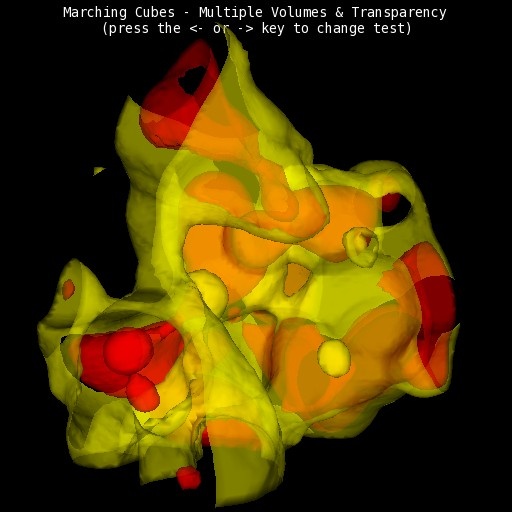
| 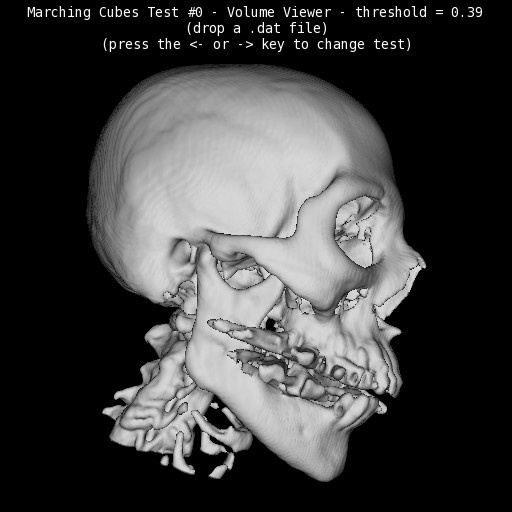
| ||
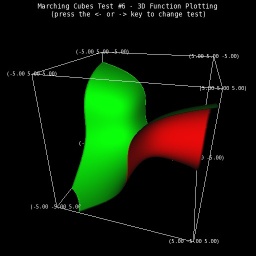
| 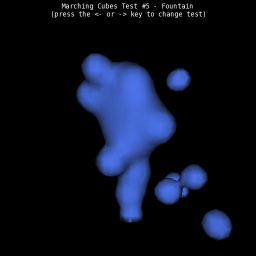
| 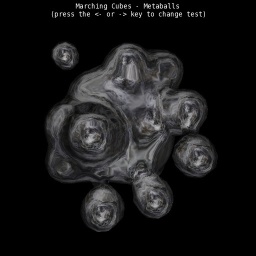
| 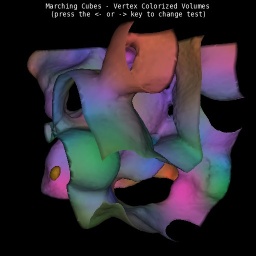
|
[From App_MarchingCubes.cpp]
class App_MarchingCubes: public BaseDemo // // This applet demonstrates: how to use marching cubes to generate isosurfaces, how to visualize multiple intersecting volumes, // how to manage transparencies, how to color the isosurface using texturing and vertex color, how to implement a simple metaballs demo // and how to simulate a metaballs/water fountain. // // Test 0: drag and drop a volume in the window and use the mouse wheel to visualize the appropriate iso-surface level. // Test 1: multiple self-intersecting transparent isosurfaces visualization. // Test 2: isosurface colorize via texturing. // Test 3: isosurface colorize via vertex color. // Test 4: animated metaball demo implemented on top of the marching cube algorithm. // Test 5: animated fountain based on marching cubes. // Test 6: 3D function plotting with vl::VolumePlot // { public: App_MarchingCubes(): mTest(4) {} void initEvent() { vl::Log::notify(appletInfo()); openglContext()->setContinuousUpdate(true); srand((unsigned int)time(NULL)); mThreshold = 0.44f; mFountainSpeed = 2.5f; // setup metaballs data mMetaball.resize(mParticleCount); mMetaballVelocity.resize(mParticleCount); mMetaballsFrames.resize(mFrameCount); for(int iframe=0; iframe<mFrameCount; ++iframe) { mMetaballsFrames[iframe].resize(mParticleCount); for(int iball=0; iball<mParticleCount; ++iball) { mMetaballsFrames[iframe][iball].x() = (rand()%100 / 100.0f)*0.6f+0.2f; mMetaballsFrames[iframe][iball].y() = (rand()%100 / 100.0f)*0.6f+0.2f; mMetaballsFrames[iframe][iball].z() = (rand()%100 / 100.0f)*0.6f+0.2f; } } // load images mVolumeImage = vl::loadImage("/volume/VLTest.dat")->convertFormat(vl::IF_LUMINANCE)->convertType(vl::IT_FLOAT); mColorImage = vl::loadImage("/volume/VLTest.dat"); // transform mTransform = new vl::Transform; rendering()->as<vl::Rendering>()->transform()->addChild( mTransform.get() ); // text setup mText = new vl::Text(); mText->setDisplayListEnabled(!vl::Has_GLES); mText->setFont( vl::defFontManager()->acquireFont("/font/bitstream-vera/VeraMono.ttf", 10) ); mText->setMargin(5); mText->setViewportAlignment(vl::AlignTop | vl::AlignHCenter); mText->setAlignment(vl::AlignTop | vl::AlignHCenter); mText->setTextAlignment(vl::TextAlignCenter); mText->setColor(vl::white); mText->setBackgroundColor(vl::fvec4(0,0,0,.75f)); mText->setBackgroundEnabled(true); mText->setText("Marching Cubes Demo"); vl::ref< vl::Effect > text_fx = new vl::Effect; text_fx->shader()->enable(vl::EN_BLEND); mTextActor = new vl::Actor( mText.get(), text_fx.get() ); sceneManager()->tree()->addActor( mTextActor.get() ); setupTest(); } virtual void updateScene() { if (mTest == 4) runTest4(); else if (mTest == 5) runTest5(); } void runTest4() { // rotate metaballs vl::vec3 axis; axis.x() = sin( vl::Time::currentTime()*3.1415f*2.0f/8.0f ); axis.y() = 0; axis.z() = cos( vl::Time::currentTime()*3.1415f*2.0f/8.0f ); axis.normalize(); if (axis.isNull()) return; mTransform->setLocalMatrix( vl::mat4::getRotation( vl::Time::currentTime()*120.0f, axis) ); // animate metaballs float t = (float)vl::fract( vl::Time::currentTime()*0.05f ); t = vl::clamp(t, 0.0f, 0.999f); int frame1 = int(t * mFrameCount); int frame2 = (frame1+1) % mFrameCount; t = vl::fract(t*mFrameCount); float Ha = 2*t*t*t - 3*t*t + 1; float Hb = -2*t*t*t + 3*t*t; for(unsigned iball=0; iball<mMetaball.size(); ++iball) mMetaball[iball] = mMetaballsFrames[frame1][iball]*Ha + mMetaballsFrames[frame2][iball]*Hb; int idx = 0; float* values = &mMarchingCubes.volumeInfo()->at(0)->volume()->value(0); for(int z=0; z<mMetaballsResolution; ++z) { float pz = (float)z/mMetaballsResolution; for(int y=0; y<mMetaballsResolution; ++y) { float py = (float)y/mMetaballsResolution; for(int x=0; x<mMetaballsResolution; ++x, ++idx) { values[idx] = metaballFunction((float)x/mMetaballsResolution, py, pz); } } } // notify that the volume data has changed mMarchingCubes.volumeInfo()->at(0)->volume()->setDataDirty(); mMarchingCubes.run(false); } void runTest5() { // animate metaballs for(unsigned iball=0; iball<mMetaball.size(); ++iball) { mMetaballVelocity[iball] -= vl::fvec3(0,1.5f,0)*(float)mTimer.elapsed()*mFountainSpeed; mMetaball[iball] = mMetaball[iball] + mMetaballVelocity[iball]*(float)mTimer.elapsed(); if (mMetaball[iball].y() < 0) { mMetaball[iball].y() = 0; mMetaball[iball].x() = 0.5f; mMetaball[iball].z() = 0.5f; mMetaballVelocity[iball].x() = (float)vl::random(-12,+12); mMetaballVelocity[iball].z() = (float)vl::random(-12,+12); mMetaballVelocity[iball].y() = 100; mMetaballVelocity[iball].normalize(); mMetaballVelocity[iball] *= (17.0f + (float)vl::random(0,5))*0.05f*mFountainSpeed; } } mTimer.start(); int idx = 0; float* values = &mMarchingCubes.volumeInfo()->at(0)->volume()->value(0); for(int z=0; z<mMetaballsResolution; ++z) { float pz = (float)z/mMetaballsResolution; for(int y=0; y<mMetaballsResolution; ++y) { float py = (float)y/mMetaballsResolution; for(int x=0; x<mMetaballsResolution; ++x, ++idx) values[idx] = metaballFunction((float)x/mMetaballsResolution, py, pz); } } // notify that the volume data has changed mMarchingCubes.volumeInfo()->at(0)->volume()->setDataDirty(); mMarchingCubes.run(false); } float metaballFunction(float x, float y, float z) { float val = 0; for(unsigned i=0; i<mMetaball.size(); ++i) { float rx = x-mMetaball[i].x(); float ry = y-mMetaball[i].y(); float rz = z-mMetaball[i].z(); float r2 = rx*rx+ry*ry+rz*rz; if (r2 == 0.0f) return 1.0e+10f; val += vl::fast1_inversesqrt(r2*r2); // threshold = 400 // val += vl::fast2_inversesqrt(r2*r2); // threshold = 400 // val += 1.0f / r2; // threshold = 400 // val += vl::fast1_inversesqrt(r2); // threshold = 70 // val += vl::fast2_inversesqrt(r2); // threshold = 70 } return val; } void keyPressEvent(unsigned short ch, vl::EKey key) { BaseDemo::keyPressEvent(ch,key); bool update = false; if (key == vl::Key_Right) { mTest++; update = true; } else if (key == vl::Key_Left) { mTest--; update = true; } if (update) { if (mTest > 6) mTest = 0; if (mTest < 0) mTest = 6; setupTest(); updateText(); } } // generates the 2 transparent volumes or a single volume vl::Actor* showVolumes(bool test1) { rendering()->as<vl::Rendering>()->camera()->setModelingMatrix( vl::mat4::getTranslation(0,0,20) ); vl::ref<vl::Geometry > geom = new vl::Geometry; geom->setVertexArray(mMarchingCubes.mVertsArray.get()); geom->setNormalArray(mMarchingCubes.mNormsArray.get()); geom->drawCalls()->push_back(mMarchingCubes.mDrawElements.get()); vl::ref<vl::Effect> fx = new vl::Effect; fx->shader()->setRenderState( new vl::Light, 0 ); fx->shader()->enable(vl::EN_LIGHTING); fx->shader()->enable(vl::EN_DEPTH_TEST); // two side lighting fx->shader()->gocLightModel()->setTwoSide(true); vl::ref<vl::Actor> act = new vl::Actor(geom.get(), fx.get(), NULL); sceneManager()->tree()->actors()->clear(); sceneManager()->tree()->addActor(act.get()); sceneManager()->tree()->addActor( mTextActor.get() ); vl::ref<vl::Volume> volume = new vl::Volume; volume->setup( (float*)mVolumeImage->pixels(), false, true, vl::fvec3(-5,-5,-5), vl::fvec3(+5,+5,+5), vl::ivec3(mVolumeImage->width(), mVolumeImage->height(), mVolumeImage->depth()) ); mMarchingCubes.reset(); mMarchingCubes.volumeInfo()->push_back( new vl::VolumeInfo( volume.get(), 0.40f, /*yellow*/vl::fvec4(1, 1, 0, 0.5f)) ); if (test1) { // generate second volume mMarchingCubes.volumeInfo()->push_back( new vl::VolumeInfo( volume.get(), 0.50f, /*red*/vl::fvec4(1, 0, 0, 0.5f)) ); // enable blend fx->shader()->enable(vl::EN_BLEND); // use color array fx->shader()->gocMaterial()->setColorMaterialEnabled(true); // polygon depth sorting act->actorEventCallbacks()->push_back( new vl::DepthSortCallback ); // binds the marching cubes color array geom->setColorArray (mMarchingCubes.mColorArray.get()); } mMarchingCubes.run(true); // stats vl::String stats; stats += vl::Say("vertices = %n\n") << mMarchingCubes.mVertsArray->size(); vl::Log::print(stats); return act.get(); } // Coloring a volume using a 3d texture can be very useful when the color of the texture is animated // i.e. changes relatively rapidly or when the isosurface itself changes or is animated. // Cons: // 1 - the texture can occupy a large amount of memory // 2 - to guarantee maximum compatibility the texture should be a cube (not a rectangle) whose side length is a power of 2. void textureVolumeColor(vl::Actor* vol_act) { if (!vl::Has_Texture_3D) { vl::Log::notify("textureVolumeColor() requires 3D texturing.\n"); return; } vl::Effect* fx = vol_act->effect(); // automatic 3D texture coordinate generation #if 1 fx->shader()->gocTextureSampler(0)->setTexture( new vl::Texture( mColorImage.get() ) ); fx->shader()->gocTexGen(0)->setGenModeS(vl::TGM_OBJECT_LINEAR); fx->shader()->gocTexGen(0)->setGenModeT(vl::TGM_OBJECT_LINEAR); fx->shader()->gocTexGen(0)->setGenModeR(vl::TGM_OBJECT_LINEAR); /* the settings below are the defaults fx->shader()->gocTexGen(0)->setObjectPlaneS(vl::fvec4(1,0,0,0)); fx->shader()->gocTexGen(0)->setObjectPlaneT(vl::fvec4(0,1,0,0)); fx->shader()->gocTexGen(0)->setObjectPlaneR(vl::fvec4(0,0,1,0)); fx->shader()->gocTexEnv(0)->setMode(vl::TEM_MODULATE);*/ vol_act->lod(0)->computeBounds(); vl::AABB box = vol_act->lod(0)->boundingBox(); // transforms object vertex coordinates to 0..1 cube, this might create a "bleeding color" effect at the very side of the cube. // note that to be really precise we should use 1/2N ... 1-1/2N in each direction instead of 0..1. vl::mat4 tex_mat = vl::mat4::getTranslation( vl::vec3(0.5f,0.5f,0.5f) ) * vl::mat4::getScaling(1.0f/box.width(),1.0f/box.height(),1.0f/box.depth()) * vl::mat4::getTranslation( -box.center() ); fx->shader()->gocTextureMatrix(0)->setMatrix((vl::fmat4)tex_mat); #endif // the above code is equivalent to the code below that manually generates the texture coordinates. #if 0 // transforms object vertex coordinates to 0..1 cube. vol_act->lod(0)->computeBounds(); vl::AABB box = vol_act->lod(0)->boundingBox(); vl::mat4 tex_mat = vl::mat4::getTranslation( vl::vec3(0.5f,0.5f,0.5f) ) * vl::mat4::getScaling(1.0f/box.width(),1.0f/box.height(),1.0f/box.depth()) * vl::mat4::getTranslation( -box.center() ); fx->shader()->gocTextureSampler(0)->setTexture( new vl::Texture( mColorImage.get() ) ); vl::ref<vl::ArrayFloat3> tex_array = new vl::ArrayFloat3; tex_array->resize( geom->vertexArray()->size() ); geom->setTexCoordArray(0, tex_array.get()); for(int i=0; i<tex_array->size(); ++i) tex_array->at(i) = ((vl::fvec4)(tex_mat * geom->vertexArray()->getAsVec4(i))).xyz(); #endif } // Coloring a volume assigning a color to each vertex directly can save memory compared to using a 3D texture, // and no 3D texturing is needed so there aren't compatibility issues. // This technique is not particularly efficient if your isosurfaces are animated and you need to recompute the colors often. void vertexVolumeColor(vl::Actor* vol_act) { vl::Geometry* geom = vl::cast<vl::Geometry>(vol_act->lod(0)); vl::Effect* fx = vol_act->effect(); // use color array fx->shader()->gocMaterial()->setColorMaterialEnabled(true); // transforms object vertex coordinates to 0..1 cube. vol_act->lod(0)->computeBounds(); vl::AABB box = vol_act->lod(0)->boundingBox(); vl::mat4 tex_mat = vl::mat4::getTranslation( vl::vec3(0.5f,0.5f,0.5f) ) * vl::mat4::getScaling(1.0f/box.width(),1.0f/box.height(),1.0f/box.depth()) * vl::mat4::getTranslation( -box.center() ); vl::ref<vl::ArrayFloat4> color_array = new vl::ArrayFloat4; color_array->resize( geom->vertexArray()->size() ); geom->setColorArray(color_array.get()); for(size_t i=0; i<color_array->size(); ++i) { vl::vec4 px = tex_mat * geom->vertexArray()->getAsVec4(i); px.x() *= mColorImage->width(); px.y() *= mColorImage->height(); px.z() *= mColorImage->depth(); color_array->at(i) = mColorImage->sampleLinear(px.x(), px.y(), px.z()); } } // Setups the good old metaballs demo! vl::Actor* setupMetaballs() { rendering()->as<vl::Rendering>()->camera()->setModelingMatrix( vl::mat4::getTranslation(0,0,25) ); sceneManager()->tree()->actors()->clear(); sceneManager()->tree()->addActor( mTextActor.get() ); vl::ref<vl::Volume> volume = new vl::Volume; mMarchingCubes.reset(); mMarchingCubes.volumeInfo()->push_back( new vl::VolumeInfo( volume.get(), 400.0f) ); mMarchingCubes.volumeInfo()->at(0)->volume()->setup( NULL, false, false, vl::fvec3(-10,-10,-10), vl::fvec3(+10,+10,+10), vl::ivec3(mMetaballsResolution,mMetaballsResolution,mMetaballsResolution) ); vl::ref<vl::Geometry > geom = new vl::Geometry; geom->setVertexArray(mMarchingCubes.mVertsArray.get()); geom->setNormalArray(mMarchingCubes.mNormsArray.get()); geom->drawCalls()->push_back(mMarchingCubes.mDrawElements.get()); // disable BufferObject since we update the vertices every frame geom->setBufferObjectEnabled(false); vl::ref<vl::Effect> fx = new vl::Effect; fx->shader()->setRenderState( new vl::Light, 0 ); fx->shader()->enable(vl::EN_LIGHTING); fx->shader()->enable(vl::EN_DEPTH_TEST); // two side lighting fx->shader()->gocLightModel()->setTwoSide(true); if (vl::Has_GL_Version_1_1) { vl::ref<vl::Image> texture = vl::loadImage("/images/spheremap.png"); fx->shader()->gocTextureSampler(0)->setTexture( new vl::Texture( texture.get() ) ); fx->shader()->gocTexGen(0)->setGenModeS(vl::TGM_SPHERE_MAP); fx->shader()->gocTexGen(0)->setGenModeT(vl::TGM_SPHERE_MAP); fx->shader()->gocTexEnv(0)->setMode(vl::TEM_BLEND); } vl::ref<vl::Actor> act = sceneManager()->tree()->addActor(geom.get(), fx.get(), mTransform.get()); return act.get(); } // Setups the metaballs fountain demo! vl::Actor* setupFountain() { rendering()->as<vl::Rendering>()->camera()->setModelingMatrix( vl::mat4::getTranslation(0,0,25) ); sceneManager()->tree()->actors()->clear(); sceneManager()->tree()->addActor( mTextActor.get() ); vl::ref<vl::Volume> volume = new vl::Volume; mMarchingCubes.reset(); mMarchingCubes.volumeInfo()->push_back( new vl::VolumeInfo( volume.get(), 400.0f) ); mMarchingCubes.volumeInfo()->at(0)->volume()->setup( NULL, false, false, vl::fvec3(-10,-10,-10), vl::fvec3(+10,+10,+10), vl::ivec3(mMetaballsResolution,mMetaballsResolution,mMetaballsResolution) ); vl::ref<vl::Geometry > geom = new vl::Geometry; geom->setBoundingBox( vl::AABB( vl::vec3(-10,-10,1-10), vl::vec3(10,10,10) ) ); geom->setBoundingSphere( geom->boundingBox() ); geom->setVertexArray(mMarchingCubes.mVertsArray.get()); geom->setNormalArray(mMarchingCubes.mNormsArray.get()); geom->drawCalls()->push_back(mMarchingCubes.mDrawElements.get()); // disable BufferObject since we update the vertices every frame geom->setBufferObjectEnabled(false); vl::ref<vl::Effect> fx = new vl::Effect; fx->shader()->setRenderState( new vl::Light, 0 ); fx->shader()->enable(vl::EN_LIGHTING); fx->shader()->enable(vl::EN_DEPTH_TEST); // two side lighting fx->shader()->gocLightModel()->setTwoSide(true); fx->shader()->gocMaterial()->setDiffuse(vl::royalblue); vl::ref<vl::Actor> act = sceneManager()->tree()->addActor(geom.get(), fx.get(), mTransform.get()); for(unsigned iball=0; iball<mMetaball.size(); ++iball) { mMetaball[iball].y() = 0; mMetaball[iball].x() = 0.5f; mMetaball[iball].z() = 0.5f; mMetaballVelocity[iball].x() = (float)vl::random(-15,+15); mMetaballVelocity[iball].z() = (float)vl::random(-15,+15); mMetaballVelocity[iball].y() = 100; mMetaballVelocity[iball].normalize(); mMetaballVelocity[iball] *= (5.0f + (float)vl::random(0,20))*0.05f*mFountainSpeed; } mTransform->setLocalMatrix(vl::mat4()); mTimer.start(); return act.get(); } class my_func: public vl::VolumePlot::Function { public: virtual float operator()(float x, float y, float z) const { // return sqrt(x*x+y*y+z*z); == 0.9f // return exp(-y)*sin(z)+cos(z*x); // == 2.0f return -x/5.0f*sin(z/5.0f)+exp(y*y*y/5.0f/5.0f/5.0f); // == 0.900f } }; // Shows how to use vl::VolumePlot to create a 3D plot. void setup3Dplot() { // reset actors and camera sceneManager()->tree()->actors()->clear(); sceneManager()->tree()->addActor( mTextActor.get() ); rendering()->as<vl::Rendering>()->camera()->setViewMatrix( vl::mat4::getLookAt( vl::vec3(5,10,20), vl::vec3(0,0,0), vl::vec3(0,1,0)) ); float range = 5.0f; vl::fvec3 min_corner(-range,-range,-range); vl::fvec3 max_corner(+range,+range,+range); vl::VolumePlot plot; plot.setMinCorner(min_corner); plot.setMaxCorner(max_corner); plot.compute( my_func(), 0.900f ); sceneManager()->tree()->addChild(plot.actorTreeMulti()); } void loadVolume(vl::ref<vl::Image> vol_img) { // reset camera rendering()->as<vl::Rendering>()->camera()->setModelingMatrix( vl::mat4::getTranslation(0,0,20) ); // reset actors sceneManager()->tree()->actors()->clear(); sceneManager()->tree()->addActor( mTextActor.get() ); // convert the image to a one-component float volume // and keep it alive since we use its data directly mDropImage = vol_img->convertFormat(vl::IF_LUMINANCE)->convertType(vl::IT_FLOAT); // note: we use the image data directly without making copies: vl::ref<vl::Volume> volume = new vl::Volume; volume->setup( (float*)mDropImage->pixels(), true, false, vl::fvec3(-5,-5,-5), vl::fvec3(+5,+5,+5), vl::ivec3(mDropImage->width(), mDropImage->height(), mDropImage->depth()) ); // start timing vl::Time time; #if 0 // downsample volume data and perform timing. time.start(); volume = volume->downsample(); vl::Log::print( vl::Say("Downsampling time = %.2n\n") << time.elapsed() ); #endif mMarchingCubes.reset(); mMarchingCubes.volumeInfo()->push_back( new vl::VolumeInfo(volume.get(), mThreshold) ); // run MarchingCubes with timing. time.start(); mMarchingCubes.run(false); vl::Log::print( vl::Say("Marching cubes: time = %.2n, verts = %n\n") << time.elapsed() << mMarchingCubes.mVertsArray->size() ); // setup isosurface geometry, actor and effect // geometry mIsosurfGeom = new vl::Geometry; // install vertex and normal arrays and primitives generated by the marching cube algorithm mIsosurfGeom->setVertexArray(mMarchingCubes.mVertsArray.get()); mIsosurfGeom->setNormalArray(mMarchingCubes.mNormsArray.get()); mIsosurfGeom->drawCalls()->push_back(mMarchingCubes.mDrawElements.get()); #if 0 time.start(); vl::PolygonSimplifier ps; ps.simplify( 0.1f, mIsosurfGeom.get() ); mIsosurfGeom->computeNormals(); vl::Log::print( vl::Say("Simplification: time = %.2n\n") << time.elapsed() ); #endif vl::ref<vl::Effect> fx = new vl::Effect; // effect fx->shader()->setRenderState( new vl::Light, 0 ); fx->shader()->enable(vl::EN_DEPTH_TEST); fx->shader()->enable(vl::EN_LIGHTING); fx->shader()->gocLightModel()->setTwoSide(true); fx->shader()->gocMaterial()->setBackDiffuse(vl::green); // show the volume in wireframe to see the tessellation. #if defined(VL_OPENGL) fx->lod(0)->push_back( new vl::Shader ); fx->shader(0,1)->enable(vl::EN_CULL_FACE); fx->shader(0,1)->enable(vl::EN_DEPTH_TEST); fx->shader(0,1)->enable(vl::EN_POLYGON_OFFSET_LINE); fx->shader(0,1)->gocPolygonOffset()->set(-1.0f, -1.0f); fx->shader(0,1)->gocPolygonMode()->set(vl::PM_LINE, vl::PM_LINE); fx->shader(0,1)->gocColor()->setValue(vl::royalblue); #endif // actor vl::ref<vl::Actor> actor = new vl::Actor(mIsosurfGeom.get(), fx.get()); // add actor to the scene sceneManager()->tree()->addActor( actor.get() ); updateText(); } void setupTest() { sceneManager()->tree()->eraseAllChildren(); if (mTest == 1) showVolumes(true); else if (mTest == 2) textureVolumeColor( showVolumes(false) ); else if (mTest == 3) vertexVolumeColor( showVolumes(false) ); else if (mTest == 4) setupMetaballs(); else if (mTest == 5) setupFountain(); else if (mTest == 6) setup3Dplot(); updateText(); } void updateText() { vl::String str; if(mTest == 0) str = vl::Say("Marching Cubes Test #0 - Volume Viewer - threshold = %.2n\n(drop a .dat file)") << mThreshold; else if(mTest == 1) str = "Marching Cubes Test #1 - Multiple Volumes & Transparency"; else if(mTest == 2) str = "Marching Cubes Test #2 - Texture Colorized Volumes"; else if(mTest == 3) str = "Marching Cubes Test #3 - Vertex Colorized Volumes"; else if(mTest == 4) str = "Marching Cubes Test #4 - Metaballs"; else if(mTest == 5) str = "Marching Cubes Test #5 - Fountain"; else if(mTest == 6) str = "Marching Cubes Test #6 - 3D Function Plotting"; str += "\n(press the <- or -> key to change test)"; mText->setText( str ); mText->setDisplayListDirty(true); } void mouseWheelEvent(int w) { if (mTest != 0) return; if (w>0) mThreshold += 0.010f; else mThreshold -= 0.010f; mThreshold = vl::clamp(mThreshold, 0.0f, 1.0f); vl::Time time; time.start(); mMarchingCubes.volumeInfo()->at(0)->setThreshold(mThreshold); mMarchingCubes.run(false); if (mIsosurfGeom) mIsosurfGeom->setBufferObjectDirty(true); vl::Log::print( vl::Say("Marching cubes: time = %.2n, verts = %n\n") << time.elapsed() << mMarchingCubes.mVertsArray->size() ); updateText(); openglContext()->update(); } void fileDroppedEvent(const std::vector<vl::String>& files) { mTest = 0; if(files.size() == 1) { if (files[0].endsWith(".dat")) { vl::ref<vl::Image> vol_img = vl::loadImage(files[0]); loadVolume(vol_img); } } else { std::vector<vl::String> files_sorted = files; std::sort(files_sorted.begin(), files_sorted.end()); std::vector< vl::ref<vl::Image> > images; for(unsigned int i=0; i<files_sorted.size(); ++i) images.push_back(vl::loadImage(files_sorted[i])->convertFormat(vl::IF_LUMINANCE)->convertType(vl::IT_UNSIGNED_BYTE)); vl::ref<vl::Image> vol_img = vl::assemble3DImage(images); if (vol_img) loadVolume(vol_img); } } void resizeEvent(int w, int h) { BaseDemo::resizeEvent(w,h); mText->setDisplayListDirty(true); } protected: vl::ref<vl::ResourceDatabase> mResDB; vl::ref<vl::Transform> mTransform; vl::ref< vl::Text > mText; vl::ref< vl::Actor > mTextActor; // volume vl::MarchingCubes mMarchingCubes; float mThreshold; std::vector<vl::fvec3> mMetaball; std::vector<vl::fvec3> mMetaballVelocity; vl::Time mTimer; std::vector< std::vector<vl::fvec3> > mMetaballsFrames; static const int mMetaballsResolution = 32; static const int mParticleCount = 25; static const int mFrameCount = 20; float mFountainSpeed; vl::ref<vl::Image> mVolumeImage; vl::ref<vl::Image> mColorImage; vl::ref<vl::Image> mDropImage; vl::ref<vl::Geometry> mIsosurfGeom; int mTest; }; // Have fun!